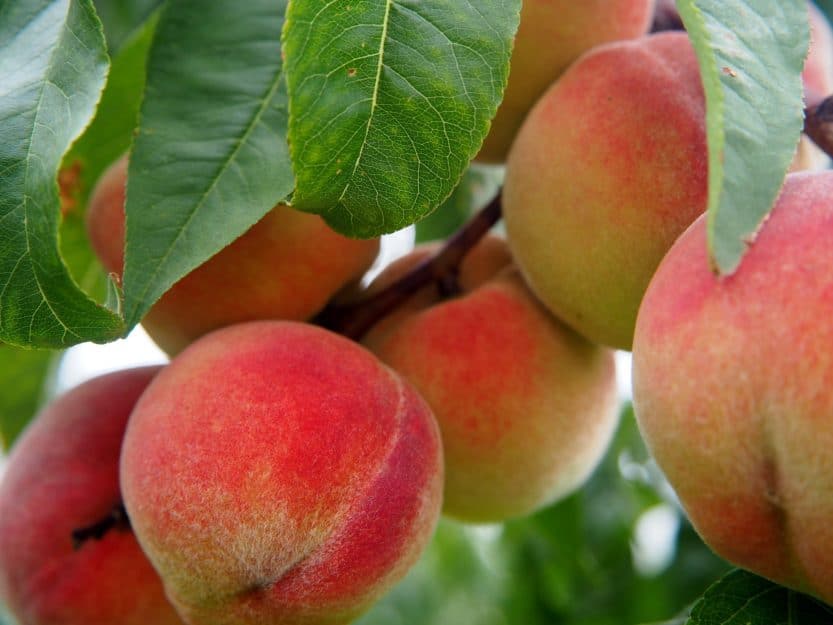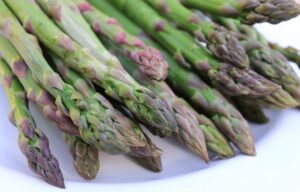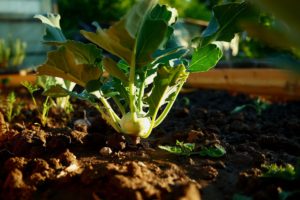Peach trees produce a soft sweet fruit, which can be a challenge to grow but will reward you with fruit for years to come. Peaches are a good source of vitamin C, vitamin A, and potassium.
Planting any fruit tree is a long-term investment, so care should be taken to select a suitable variety. Also be sure the site you pick can support the tree over its lifetime. Most peach trees prefer a warm climate, yet some peach varieties have been bred to handle winter temperatures as low as -10 degrees Fahrenheit (-23 C).
Buy Peach Trees Online
| Image | Name | Rating | Shop |
|---|---|---|---|
 | Elberta Peach Tree – Nature Hills Nursery |
Peach Tree Varieties
Another important consideration when choosing a variety of peach is disease resistance. Peach trees are highly susceptible to molds, fungus, and rusts. If you live in a climate that tends to promote any of these diseases, then make sure to select a peach variety that has resistance to any of the problems common to your region.
Do Peach Trees Need to Cross Pollinate?
While peach trees are largely self-pollinating, yields can be increased, if you plant more than one tree. If space is at a premium, you can find dwarf peach trees for sale in most catalogs. Dwarf peach trees can be found with all the disease-resistant traits you may need in your location.
Dwarf Peach Trees
Dwarf peach trees are a good choice, even if your growing area is not limited, because you can have more varieties of peaches planted in the same space that one standard peach tree would occupy. Dwarf peach trees also yield their harvest earlier than standard peach trees, and pruning shorter trees is much easier.
What Time of Year Do You Plant Peach Trees?
The best time to purchase a peach tree is in the early spring, once the ground has thawed and is easily worked. In some cold climates, you can plant peach trees in the summer; but most varieties do well when they are planted in spring. Most peach trees are planted as young, one-year-old trees purchased from a nursery.
Once you have selected the variety you want and you have it in your possession, it is best to get the tree in the ground as soon as possible. If the roots appear dry, or the plants were mail ordered, it might be best to soak the roots for twenty-four hours before planting.
Can You Grow a Peach Tree from a Peach Pit?
While it is possible to start a peach tree from a seed, it’s best to buy a known variety from a nursery. Trees planted from seed might not be able to survive your local conditions or will not have the flavor and disease resistance of a tree from a nursery.
Planting Peach Trees
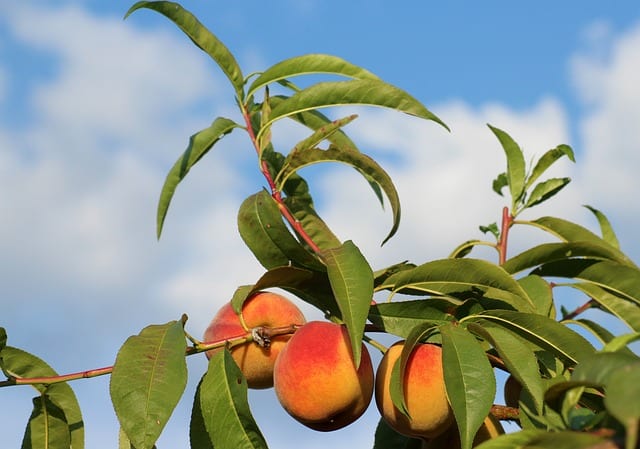
Do Peach Trees Need Full Sun?
Peach trees need full sun, so make sure to plant them in a location that gets sun for most of the day and will not be obstructed over the lifetime of the tree. The soil in which you plant your peach tree should be sandy soil that has good drainage.
Peach Tree Soil Requirements

A peach tree will be in its current location for years to come, so it’s a good idea to test the soil where you plan to plant the tree. If any nutrient deficiencies or pH problems are detected, rectify them before planting the tree. Once the soil (Buy Online) in the surrounding area has been amended, dig a hole about 18 inches deep and mix in some compost, so that the young roots will have a good start.
Peach Tree Spacing
If you are planting dwarf trees, aim for a spacing of 10 feet (32.4 m); and if you are planting standard trees, place them 15 feet (5 m) apart. Make sure to avoid planting your peach trees in low points or frost pockets on your property, as this might lead to bud loss on the tree in the early spring, which can ruin any chance of getting peaches if that happens. If this cannot be avoided, then choose a variety that comes out of dormancy and blooms later in the spring.
How Deep Do You Plant Peach Trees?
Once you are ready to put your tree into the ground, dig a hole just deep enough that the roots can be evenly spread out and the crown is 2 inches (5 cm) above the soil line. Make sure the soil underneath the roots is loose so that the roots are able to quickly establish themselves.
Gently backfill the soil around the tree, gently tamping the soil down as you push it back in. Make sure, as you work, that the tree is staying upright. Check that the graft union is not covered with dirt, as this can lead to disease and the death of the tree. No fertilizer should be added at this time, in order to limit the risk of burning the roots.
Peach Tree Care & Harvest
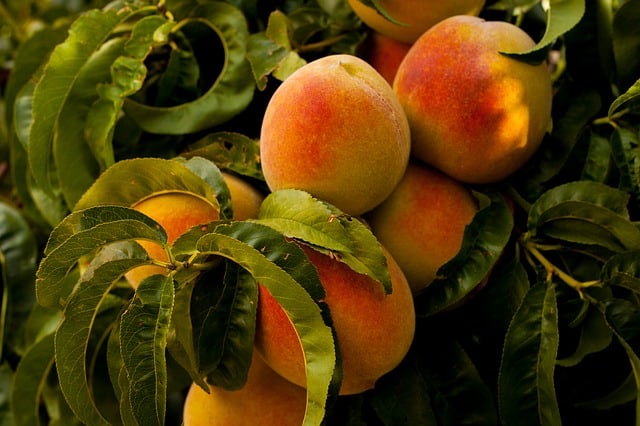
Peach Tree Water Requirements
Water the tree in very well after it’s planted, as this will allow the soil to settle by pushing out any air pockets. While the tree is getting established, deeply water it every week. After the tree is established, natural rainfall should provide enough water. In some areas, rainfall might not be enough; so, in that case, 1 to 2 inches (2.5 to 5 cm) of water every other week should suffice.
As the tree ages, water less towards the trunk and more towards the perimeter of the tree, near the leaves’ drip line, as this is where the roots are most actively taking up water. Mulch can be added around the tree, being careful not to allow the mulch to touch the trunk of the tree, as this can encourage rot along the base of the tree.
Fertilizing Peach Trees
Peach trees should be fertilized twice a year. Fertilize the tree once in the early spring, and then apply the second round of fertilizer (Buy Online) two months before the first frost in your area.
Peach Tree Pests
Growing peach trees comes with a host of insect and disease problems, which you will have to contend with throughout the life of the tree. You can get ahead of these problems by doing preventative maintenance.
Spraying Peach Trees
Once the tree is a week or two old, you can spray the tree with a mild pesticide in order to prevent any early insect damage. It is also a good idea to shield the trunk of the tree with wire mesh early in its life, in order to protect it from rodent damage. As the tree matures, you might have to protect the trunk from sun scald with an opaque trunk covering.
Peach Tree Leaf Curl Treatment
Another very common problem that most peach growers will encounter is “peach leaf curl,” and you can try to prevent this by spraying the leaves with a lime-sulfur mixture every year.
Thinning Peaches
When the tree begins to produce its first harvest, you should thin the fruit down to just a few, well-spaced peaches, so that the branches do not get overcrowded.
When are Peaches in Season?
Harvest times vary for different varieties, but most peaches are ready to harvest in late July or early August. Wait until the peaches are easy to remove from the tree; and if they resist your pulling them from the branch, then wait another few days, in order to limit any potential damage to the tree.
How to Tell When a Peach is Ripe
Peaches tend to ripen from the outside of the tree inwards. Peaches will change color from green to yellow; and with sufficient sun exposure, they will develop a reddish-pink hue on the sun-facing side.
Remove any decaying peaches from the base of your trees, in order to reduce insects and other diseases that might damage your tree in the future. Peaches are a very delicate fruit, so be careful not to bruise them, or they will begin to rot very quickly.
Storing Peaches at Home
Fresh peaches should only be stored for a few days at room temperature. If you want to store them in the refrigerator, they will last up to a week. For long-term storage, you could make peach jam, freeze peach slices or can peach halves or slices in syrup.


